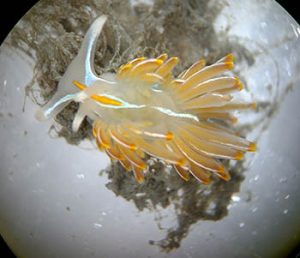Citizen scientists, the Prince William Sound College, the Smithsonian Environmental Research Center, and the council partner for invasive species event in Prince William Sound
Linda McCann
Smithsonian Environmental Research Center

A crew of marine biologists ventured to Prince William Sound this September for the third Smithsonian-led “bioblitz” in Alaska, this time in Valdez. During a bioblitz, volunteer citizen scientists team up with professional scientists to search for invasive marine invertebrates. This year, the Smithsonian partnered with the council and Prince William Sound College for a week of scientific sampling.
Three months before the bioblitz, council staff placed “settlement plates,” sheets of sanded PVC that the invertebrates attach to over time. During the bioblitz, volunteers and staff collected the plates, towed plankton nets, set crab traps, and went scuba diving, to look for various nonnative species.
The study helped establish critical baseline data for future research, invasive species management, and conservation initiatives. Fortunately, no new non-native species were found during the bioblitz or the scientific sampling.
Earlier in the week, Smithsonian and council staff took samples near Tatitlek and near the Alyeska terminal. One species of non-native bryozoan was found on the research dives at Tatitlek, Schizoporella japonica. This species, native to Japan, has been found at many localities around Alaska, including Valdez, but has not been seen there recently.
After a day of lectures and hands-on training in the lab, community volunteers and students surveyed the Valdez harbor for the non-native species they’d learned about. Among other marine creatures, they found many clams, crabs, bryozoans, anemones and marine tubeworms.
The Smithsonian conducts this research as part of a program called the Invasive Tunicate Network. The network includes teachers, students, outdoor enthusiasts, environmental groups, and state and federal biologists who are monitoring for non-native tunicates and other invasive species along the U.S. West Coast, with a primary focus on Alaska. See platewatch.nisbase.org for a complete listing.
Bioblitz 2016 Re-assessing Marine Invasions In Valdez, Prince William Sound, Alaska